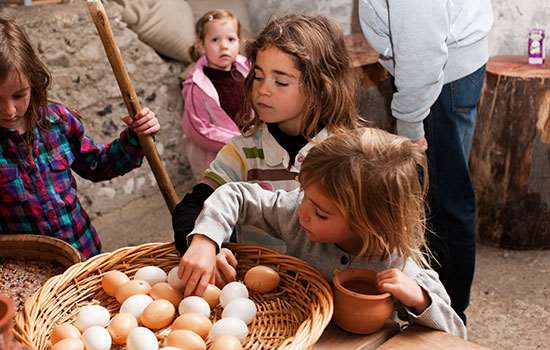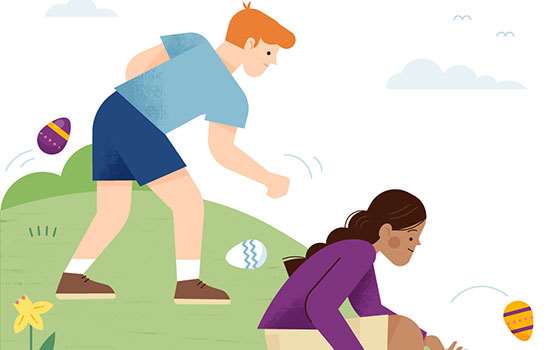1. Why Easter’s date changes every year
Easter is what some people call a ‘movable feast’ because, as most people know, its date differs from year to year. That's because its date is calculated using the lunar calendar, or monthly cycle of the moon. Since the 4th century, Christians have celebrated Easter on the Sunday following the first full moon after the Spring Equinox. This seems straightforward. However, there was huge disagreement about the date of the Spring Equinox, how to calculate the lunar month, even the hour of the day when Easter Sunday began and so this meant that different Christian traditions had their own calculations for determining the date of Easter. In the mid-7th Century, two such traditions came head to head in the Anglo-Saxon kingdom of Northumbria. One side followed calculations used in Rome and mainland Europe, the other a method used in parts of Ireland.
The question was at long last settled in 664 at the Synod of Whitby, a meeting of leading clergy and nobles. It was agreed to use the Roman method for calculating Easter and this is the method we still use today.
2. Easter was once banned
By the late Middle Ages, Easter was marked by elaborate religious services. These included a procession on Palm Sunday, ‘Creeping to the Cross’ on Good Friday and the placing of a sculpture of Christ and the ‘consecrated host’ (communion wafer) in a symbolic tomb called an Easter Sepulchre, where they would remain until they were symbolically resurrected on the morning of Easter Sunday. Easter was also one of the few times each year that a person would receive Communion, or the Eucharist.
In England, many of these ceremonies were targeted by Protestant religious reformers during the Reformation, and the Puritans, who gained power after the Civil War in the mid-17th Century, took radical religious reform to the next level: In 1647, Parliament abolished Easter and all other Holy Days. Easter Sunday became just an ordinary Sunday. In 1660, Charles II (the ‘merry monarch’) was restored to the English throne and Easter Sunday festivities returned to the calendar of the Church of England.
3. Good Friday Hot Cross Buns were believed to protect against bad luck
There’s a centuries’ old tradition of baking special bread, biscuits or buns on Good Friday. Marked with a cross, by the early 18th century they were known as Hot Cross Buns: In 1733 London street vendors advertised their wares with the cry 'One a-penny, two a-penny, Hot Cross Buns!'
Biscuits and buns baked on Good Friday were believed never to go mouldy and to be capable of curing diseases, especially those affecting the stomach. Some were even hung in homes and were thought to protect against misfortune. Click here to find a traditional recipe for Hot Cross Buns and Simnel Cake.
It’s possible that these traditions are an echo of medieval beliefs about the miraculous powers of the consecrated host, which was also decorated with a small cross. As we’ve already seen, the host played an important part in medieval Easter services.
4. Eggs were rolled for Easter entertainment
Since the time of the Anglo-Saxons, Easter has been marked with a holiday and a break from work, making it the perfect opportunity for fun and games. Traditional Easter, or ‘Hocktide’ pursuits included archery, even rolling hard boiled eggs down hills. Easter sports sometimes involved a lot of rough and tumble. Since 1779, the Easter weekend in Workington, Cumbria, has been marked by a mass football ‘match’ called the ‘Uppies and Downies.’ Not for the faint hearted, rules are few and far between, and serious injuries, even deaths have occurred!
5. King Edward 1 gifted 450 decorated Easter eggs
Readily associated with new life, the giving of eggs has long been synonymous with Easter. In 1290, Edward I purchased 450 eggs which were painted or covered in gold leaf before being distributed to members of the royal entourage. Henry VIII received an egg enclosed in a silver case as an Easter present from the Pope in Rome. Fees due to the Church at Easter were sometimes paid using eggs, which at medieval Durham were known as ‘eggsilver.’ Eggs were also collected at Easter to be distributed to the poor as charity. Today the most popular gifted egg is of course made from chocolate, complete with colourful foil decoration. Originally dark chocolate was used and the first English chocolate egg was sold by Fry’s in 1873; milk chocolate later became the most popular type of Easter egg after it was introduced by Cadbury in 1897. Find out more about the History of Chocolate here.
MORE TO EXPLORE
-

How the English Celebrated Easter
Over the centuries, Easter has become associated with many different traditions. From baked goods to ball games and bunnies, discover some of the ways that the English have celebrated Easter throughout history.
-

Why do we eat eggs at Easter
Discover the medieval tradition of decorating eggs by dying them in bright colours, why an egg roll doesn’t actually involve any bread, and follow our instructions to make your own colourful pace eggs.
-

THE ENGLISH HERITAGE PODCAST
Join presenter Charles Rowe as we bring the history of our sites to life with news, views and expert interviews across over 100 episodes.
